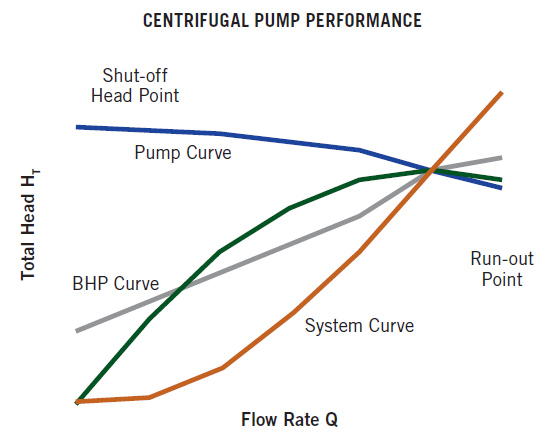Centrifugal Pumps Preventive Maintenance Checklist
Pump manufacturers supply a manual with recommended maintenance procedures for their centrifugal pumps. However, routine preventive and protective maintenance practices should, at a minimum, include the monitoring of the following:
| Procedure | Description |
|---|---|
| Bearing and lubricant condition | Monitor bearing temperatures, lubricant level, and vibration. The lubricant should be clear with no signs of frothing. Excessive vibration and an increase in bearing temperature may indicate imminent failure |
| Shaft seal condition | The mechanical seals should show no signs of visible leakage. Some packing leaking is normal, but this should not exceed a rate of about 40 to 60 drops per minute |
| Pump discharge pressure | A gradual decrease in the developed head pressure of the pump may indicate that the impeller clearance has widened. An impeller clearance adjustment may be required to restore the pump to its intended design performance |
Annual maintenance

Once a year, the pump’s performance should be checked and recorded in detail. Performance benchmarks should be established for a new pump during the early stages of a pump’s operation, when the installation adjustments are correct. This benchmarking data should include:
- The head pressure developed, as measured by the suction and discharge gauges
- Centrifugal pump flow rate
- Motor amp draw
- Pump vibration signature
Quarterly maintenance
The following maintenance tasks should be performed on a quarterly basis:
- Verify the integrity of the pump’s foundation and check the hold-down bolts for tightness.
- For oil-lubricated pumps, change the oil after the first 200 hours of operation for a new pump, and then after every three months or 2,000 operating hours, whichever comes first. For grease-lubricated pumps, bearings should be greased every three months or 2,000 operating hours, whichever comes first.
- Check the shaft alignment.
- Grease the motor bearings according to the manufacturer’s instructions.
Additional parts examination
| Procedure on Bearing | Description |
|---|---|
| Frame and foot | Inspect for cracks, roughness, rust, or scale. Machined surfaces should be free of pitting or erosion |
| Frame | Inspect all tapped connections for dirt. Clean and chase threads as necessary. Remove all loose or foreign material. Inspect lubrication passages to be sure that they are not blocked |
| Shaft and sleeve | Inspect for grooves or pitting. Check bearing fits and shaft runout, and replace the shaft and sleeve if worn or if the shaft runout is greater than 0.002 inches |
| Casing | Inspect for signs of wear, corrosion, or pitting. If wear exceeds a depth of 1/8-inch, the casing should be replaced. Check gasket surfaces for signs of irregularities |
| Impeller | Inspect the impeller for wear, erosion, or corrosion damage. If the vanes are bent or show wear in excess of 1/8-inch deep, the impeller should be replaced |
| Frame adapter | Inspect for cracks, warpage, or corrosion damage and replace if any of these conditions is present |
| Bearing housing | Inspect for signs of wear, corrosion, cracks or pits. Replace housings if worn or out of tolerance |
| Seal chamber/stuffing box cover | Check for pitting, cracks, erosion or corrosion. Inspect for any wear, scoring or grooves that might be on the chamber face. Replace if worn more than 1/8-inch deep |
| Shaft | Check the shaft for any evidence of corrosion or wear and straightness, noting that the maximum total indicator reading (TIR) at the sleeve journal and coupling journal should not exceed 0.002 inches |
